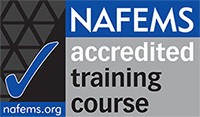| ID | Competence Statement |
| FEAkn1 | List the various steps in the analysis/simulation process. |
| FEAkn2 | Define the meaning of degree of freedom. |
| FEAkn3 | List the nodal degrees of freedom and the associated force actions for common beam, 2D solid, 2D axisymmetric, 3D solid and shell elements, for the Displacement FEM. |
| FEAkn4 | Define the meaning of adaptive mesh refinement |
| FEAkn8 | List the requirements for an axisymmetric analysis to be valid. |
| FEAkn9 | List the degrees of freedom to be constrained on a symmetric boundary. |
| FEAkn12 | List the advantages of using symmetry. |
| FEAkn16 | List the various forms of element distortion. |
| FEAkn17 | List the various element types commonly used in the analysis of components within your organisation. |
| FEAco1 | Describe the sources of error inherent in finite element analysis, in general terms. |
| FEAco2 | Discuss checks that may be used post-solution to check for the presence of inaccuracy. |
| FEAco5 | Discuss the difficulties that can arise in using a CAD model as the basis for carrying out analysis and simulation. |
| FEAco6 | Discuss the need for a consistent set of units in any analysis and illustrate possible pitfalls. |
| FEAco7 | Explain why strains and stresses are generally less accurate than displacements for any given mesh of elements, using the Displacement FEM. |
| FEAco11 | Discuss the finite element / spring analogy. |
| FEAco14 | Discuss the nature of the structural stiffness matrix. |
| FEAco15 | Discuss the integral equation for element stiffness, highlighting the variables which it is dependent upon. |
| FEAco24 | Discuss the relationship between shape function and strain/stress prediction for simple 2D linear and parabolic elements. |
| FEAco26 | Discuss the significance of computer memory to solution elapse time for large models. |
| FEAco29 | Discuss the term Flying Structure or Insufficiently Constrained Structure. |
| FEAco31 | Explain why most finite elements do not represent a circular boundary exactly and highlight how this approximation manifests itself. |
| FEAco35 | Discuss the terms Validation and Verification and highlight their importance. |
| FEAco40 | Explain the rationale behind the use of 1-D, 2-D and 3-D elements used in the analysis of components within your organisation. |
| FEAap2 | Demonstrate effective use of available results presentation facilities. |
| FEAap3 | Illustrate the approximate nature of finite element analysis, through examples chosen from your industry sector. |
| FEAap5 | Illustrate possible applications of 0D, 1D, 2D and 3D elements in your industry sector. |
| FEAap6 | Illustrate how you might apply a moment to a model consisting of 2D or 3D solids. |
| FEAap7 | Employ symmetric boundary conditions effectively. |
| FEAap10 | Illustrate various physical situations which will result in a Stress Singularity and explain why it is not appropriate to use finite element results at such locations directly. |
| FEAap12 | Employ a range of post-solution checks to determine the integrity of FEA results. |
| FEAap13 | Conduct validation studies in support of FEA. |
| FEAan1 | Analyse the results from small displacement, linear static analyses and determine whether they satisfy inherent assumption |
| FEAan2 | Compare the results from small displacement, linear elastic analyses with allowable values and comment on findings. |



